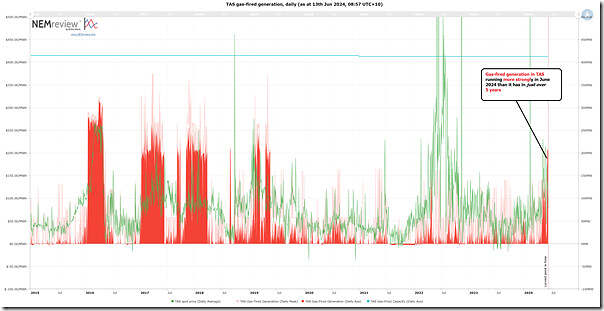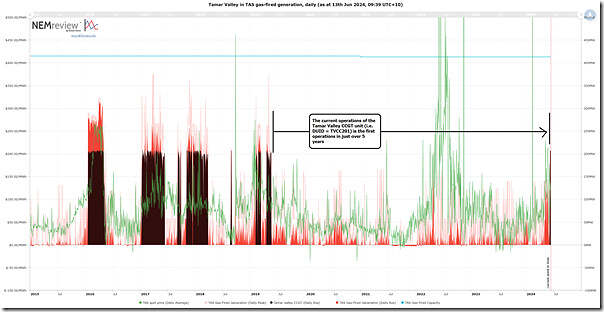Earlier this morning we noted ‘Wind yield drops again, prices rise in VIC, SA and TAS … and gas-fired generation is running strong’ … but it’s worth particularly noting the situation in Tasmania, which we show firstly with this trend of daily statistics for gas-fired generation in TAS looking back 10 years:
This chart from NEMreview v7 clearly shows that the the last few days have seen the strongest block of gas-fired production in TAS since May 2019 … just over 5 years ago.
Those with a licence to the software can open their own copy of this query here.
In subsequent articles (time permitting) we might delve further into the reasons for this (i.e. hydro storage levels are relatively low … but how do they compare to historical levels, especially at the start of winter?).
Out of curiosity, I edited a copy of the trend above to explicitly add in the daily average production from the ‘TVCC201’ unit (i.e. the Tamar Valley CCGT):
This confirms that it’s the first time in just over 5 years that the combined cycle unit has seen a run!
—
With a number of the commentators at Australian Energy Week speaking about the design challenges of the Capacity Investment Scheme (which some would see as ideologically driven, but logically inane for excluding gas-fired generation), this very intermittent – but very necessary – use of gas-fired generation in Tassie …
1) is another reminder of what most credible models of the energy transition find that a large installed capacity base is going to be required of gas-fired peaking plant;
2) but it’s not going to need to be run very often;
… as noted in this paper from Simshauser and Gilmore, for instance
3) which means that the emissions from the plant will be quite low;
4) but the economics are going to need to stack up, meaning:
(a) There’s going to need to be some incentive for the plant to be built and maintained; and
(b) We’ll need to work out how to fuel it … with gas supply, and/or back-up liquid fuel or possibly even biofuels.
(c) The costs of the above need to be accounted for.




The rains are late and storages are closing in on the ‘prudent storage level’. Storage levels are the lowest at this time of year since at least 2018. Reference to the Tasmanian Economic Regulator’s website – link hopefully included. [https://www.economicregulator.tas.gov.au/about-us/energy-security-monitor-and-assessor/tasmanian-energy-security-monthly-dashboard]